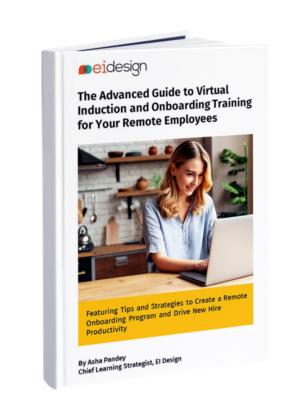The Advanced Guide To Virtual Induction And Onboarding Training For Your Remote Employees
This eBook provides insights that will help you handle the transition of moving face-to-face induction and onboarding programs to a virtual mode effectively.

This eBook provides insights that will help you handle the transition of moving face-to-face induction and onboarding programs to a virtual mode effectively.
Did you know that in the initial 45 days of joining a new organization, 1 in 5 employees determine if they should drop out?
Recruitment is a high-priced and time-consuming procedure. After the right candidates have been selected for the job, specific measures need to be put in place to induct and onboard them as quickly and efficiently as possible. This evidently upholds the necessity for a well-structured and equally well-executed corporate induction and onboarding training program to make sure that new employees are not disenchanted. Notably, it should help enhance the positive image of the organization.
The conventional face-to-face method to provide induction and onboarding programs is typically the method most organizations opt for. This is highly impactful, and the human touch goes a long way in aiding new employees to learn the organization culture, its value proposition, and how they can contribute very effectively.
However, given that COVID-19 has led to changed workplace dynamics, organizations must consider moving the face-to-face induction and onboarding programs to a virtual mode.
Section 1 – How to Choose the Right Approach for Delivering Virtual Induction and Onboarding Training
This section begins with the aspects you must consider as you move to a virtual induction and onboarding program. It lists the challenges associated with inducting and onboarding remote employees – without human touch points. It also outlines two approaches to consider when moving the ILT induction and onboarding program to a virtual mode. It concludes by explaining why organizations are pivoting to blended induction and onboarding programs to meet the entire spectrum of the training needs.
Section 2 – What Tips and Best Practices Can Be Used for Virtual Induction and Onboarding Training
Even though we are facing a global pandemic, there is still a need to implement a strong induction and onboarding program for new employees. They may take the Induction and Onboarding sessions from their home or in a half empty workspace, but the program needs to deliver the requisite value. This section lists out tips and best practices to onboard new employees remotely in the midst COVID-19.
Section 3 – How to Promote Organizational Culture in Virtual Induction and Onboarding Training
In the conventional mode, organizations functioned with centralized corporate training centers where they carried out Instructor-Led Induction Training (ILT) to their new employees. This section clarifies that in the changed workplace dynamics, blended learning is possibly the most effective approach to such training and can help reinforce the cultural norms expected from these new entrants.
Section 4 – How to Shorten New Hire Time-to-productivity with Virtual Induction and Onboarding Training
This section outlines how knowledge transfer and skills enhancement remain a key focus area of employee onboarding training and time-to-productivity is one metric underpinning the success of such programs. The section goes on to further illustrate strategies and tips that can shorten time-to-productivity through employee onboarding training.
Section 5 – How Can Mobile Learning Be Used to Create Effective Virtual Induction and Onboarding Training Programs
This section talks about how it is imperative to include mLearning or mobile learning in your virtual induction and onboarding training strategy, with a majority of the new hires now working from home.
It lists out why mobile learning for induction and onboarding training can be beneficial for both learners as well as the organization. It also includes learning strategies that can be used to create effective virtual induction and onboarding training programs.
Section 6 – Case Study – On Transition of a Face-to-Face Induction and Onboarding program to a Virtual (Blended 2.0) Mode
Induction and onboarding is an ongoing and recurrent activity for an organization on a growth path. This section showcases a case study on how we successfully transformed our predominantly classroom-based induction and onboarding program to a Blended 2.0 mode.